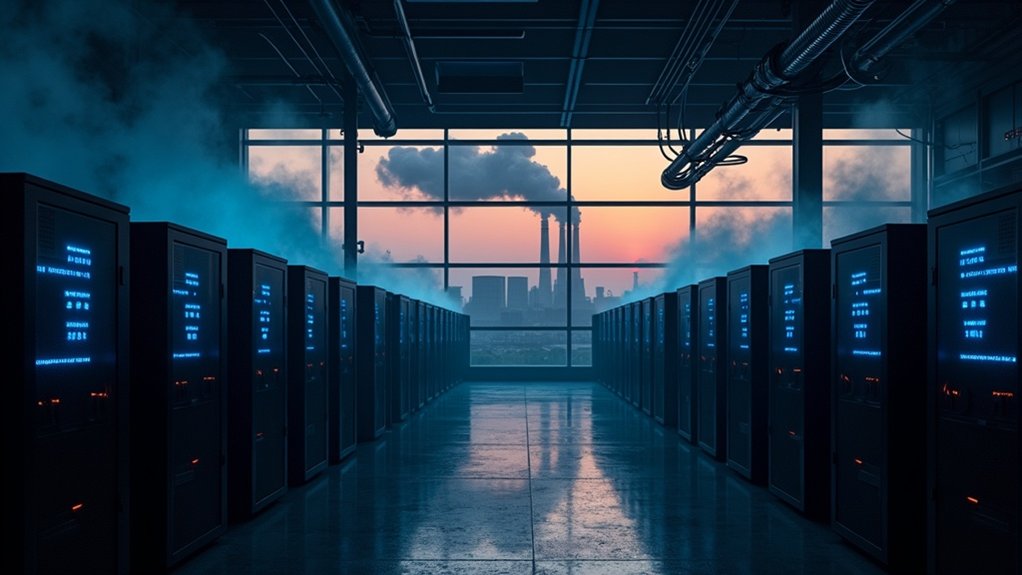Bitcoin mining’s profitability looks increasingly questionable. It devours massive electricity (32.3 terawatt-hours annually in the US alone), mostly from fossil fuels. The environmental costs are staggering—86 megatons of carbon emissions globally, requiring 3.9 billion trees to offset. Plus, it’s creating air pollution affecting millions of Americans. Miners chase profits through cheaper electricity and efficient hardware, but with high startup costs and environmental damage, the math doesn’t add up for most people. The full picture gets even grimmer.
How much environmental damage is too much for digital money?
Bitcoin mining gulped down 32.3 terawatt-hours of electricity in the U.S. alone from mid-2022 to mid-2023.
Bitcoin’s power addiction: 32.3 terawatt-hours devoured across America in just 12 months – enough to light up Los Angeles and then some.
That’s 33% more than what powers all of Los Angeles.
And it’s not clean energy, folks.
About 85% of that electricity comes from fossil fuels.
Let that sink in.
While mining rewards currently sit at 3.125 bitcoins per block, the environmental cost keeps mounting.
The global picture isn’t prettier.
Bitcoin mining spewed roughly 86 megatons of carbon into our atmosphere.
China’s coal-hungry mining operations alone generated more than 41 million metric tons of CO2 equivalent in 2020-2021.
Half the world’s Bitcoin electricity still comes from fossil fuels.
If Bitcoin were a country, its energy consumption would rank 27th globally, surpassing Pakistan’s entire national usage.
Progress? Not really.
It’s not just about invisible carbon.
Real people breathe worse air because of this digital gold rush.
Bitcoin mining exposed 1.9 million Americans to harmful levels of PM2.5 pollution.
And this dirty air doesn’t stay put – it travels across state lines, hitting places like New York City, Houston, and Austin particularly hard.
People cough while miners compute.
Water usage? Staggering.
Bitcoin’s global water footprint hit 1.65 km³ in 2020-2021.
That’s more water than 300 million rural sub-Saharan Africans use domestically.
Want to offset the carbon?
You’d need to plant 3.9 billion trees – covering land the size of the Netherlands.
The economics are as volatile as the currency itself.
Profitability hinges on electricity costs, mining difficulty, Bitcoin’s price, and hardware efficiency.
Those specialized ASIC miners aren’t cheap, and their payback period fluctuates wildly with market conditions.
Some miners chase cheaper electricity or renewable sources to boost profits.
But with only 2% solar and 5% wind powering global Bitcoin mining, it’s hardly a green revolution.
A recent study published in Nature Communications reveals the alarming cross-state pollution effects that demand federal regulation, as individual states cannot regulate each other’s harmful mining activities.
Frequently Asked Questions
How Much Electricity Does Bitcoin Mining Consume?
Bitcoin mining consumes a staggering 140.3 TWh of electricity annually in 2025.
That’s more than entire countries like Argentina.
Each Bitcoin requires 854,400 kWh to mine—enough to power 81 American homes for a year.
Just one transaction? 1,335 kWh.
Mining farms collectively draw up to 44 GW during peak operations.
Despite 54% of mining using renewable energy, the network’s appetite keeps growing as hashrates climb.
Environmental nightmare or technological marvel? Depends who you ask.
Can Bitcoin Mining Damage My Computer Hardware?
Yes, Bitcoin mining can absolutely damage computer hardware.
Standard PCs aren’t built for this kind of punishment.
The constant high loads create excessive heat and accelerate wear on components.
ASICs typically last only 1.3-5 years under ideal conditions.
Consumer hardware? Way worse.
GPUs get cooked.
Hard drives fail from constant write cycles.
Manufacturers won’t cover this damage under warranty either.
Mining rigs need specialized cooling systems just to survive.
The hardware toll is real and expensive.
Is Bitcoin Mining Legal in All Countries?
Bitcoin mining isn’t legal everywhere.
It’s fully legal in countries like the US, Canada, and Germany—with proper tax compliance, of course.
Some places have conditions—Kazakhstan and Russia require licenses or have quotas.
But China? Total ban since 2021.
Nepal, Morocco, and Algeria have outlawed it too.
Many countries fall into gray areas with evolving regulations.
Environmental concerns are changing the landscape fast.
The legality map keeps shifting as governments figure out how to handle crypto.
How Noisy Are Bitcoin Mining Rigs?
Bitcoin mining rigs are LOUD.
We’re talking 70-90 decibels per machine—comparable to standing near a fighter jet. Yeah, seriously.
The main culprits? Those high-speed cooling fans running 24/7.
Large operations with hundreds of machines can reach 95+ decibels and be heard up to a mile away.
Some miners install liquid cooling or better fans to cut the noise.
Others just move operations to remote locations.
Either way, your neighbors won’t be thrilled.
Can I Mine Bitcoin on My Smartphone?
No, mining Bitcoin directly on a smartphone is practically impossible.
Mobile devices lack the computational power and cooling systems needed for traditional Bitcoin mining.
The economic reality? Your phone would burn out before mining anything significant.
Some mobile “mining” apps exist, but they’re mostly cloud mining services where users purchase contracts.
The hybrid Solaris model tries to make it viable, but it’s not true Bitcoin mining.
Just technical limitations at work.









